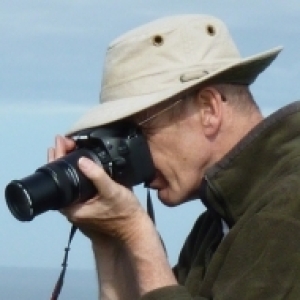Possible Atlas Pied Flycatcher
When I blipped the Goldcrest, I hinted that I might need to go see this possible Atlas Pied Flycatcher at Flamborough and Mrs L took the hint, so a reasonably early start and we'd covered the 200 miles and were in the car park at East Landing by 11:00. A parking ticket for a couple of hours was purchased (that'd be plenty) and off we set.
The bird had been frequenting a wooded gorge which was surrounded by a U shaped path. We came across the expected birders round the bridge that formed the bend in the U. That's where the bird had been last seen, but nobody had seen it for over half an hour. Maybe ten minutes later there was a rush to the far end of the gorge. The bird was there, but moving around in the tree canopy quite a bit. Those that had it were giving directions to those that hadn't - between those two trees - on that branch going up left - in the V of those branches - where the Beech and the Elm meet. Excuse me, but this is a wooded gorge, it's full of bloody trees, which two trees, which branch, which V, which Beech - you may have gathered that I was one of those struggling to find the bird.
I'd seen something, but not great and certainly not identifiable by me and definitely no photo. This went on for a while. It then was lost from view on our side of the gorge, but the birders we could see on the far side seemed to be watching intently. So even though the sun was in a better position for our side I decided to go all the way round the U to see what I could see. There the frustration continued, although I got a view of what really was just a silhouette given the sun's position, through another birders scope I couldn't find it in my binoculars and definitely not through the camera.
I headed back to the far side, Mrs L had various sightings, but I still struggled. Eventually birders started to leave, satisfied with their views, our two hours in the car park was almost up. Mrs L headed back to buy another two hours. Eventually I was the only birder left on the far side, no sign of the bird I dejectedly started to wander back. I met Mrs L and seemingly those birders on the near side could see the bird although Mrs L couldn't, but when we reached them , the bird was out of sight for them, but with the confirmation it was still in the area we'd been concentrating on we returned to the far side yet again.
Our luck then changed. Over the next half hour we got some good views of the bird and I even got the camera onto it. Roles were reversed and it was me giving directions to those that couldn't find the bird - between those two trees - on that branch going up left - in the V of those branches - where the Beech and the Elm meet!!
There have been some cracking photos of this bird published on the web and yup, mine's don't come close to being in that category, but they are at least recognisable and that'll do nicely thank you. As to whether it is Britain's first ever Atlas Pied Flycatcher, well I'll leave that to those that are DNA testing feathers taken from when the bird was ringed, but in my opinion and reading my Collins guide I'm not sure. The distinguishing features of the Atlas is a very large white patch on the forehead, as opposed to a small patch on a Pied Flycatcher, okay this bird has a large patch, but so does an Iberian Pied Flycatcher. In an Atlas it's supposed to have a large white patch on the wing, this bird's wing patch looks fairly Pied Flycatcher / Iberian Pied Flycatcher sized and finally it's not the norm for an Atlas to have a pale patch on the back, which this bird does and it is for an Iberian Pied Flycatcher, but there again the "in-hand" biometrics, apparently, conclusively rule out Iberian Pied Flycatcher - we'll await the DNA
For those that want a little further information here are some interesting articles:
RBA Weekly review: 02 May - 08 May 2012
RBA Weekly review: 25 April - 01 May 2012
LGRE's View on the bird
Discovered & Photographed
Trapped & Ringed
Anyway enough of the esoterics of birdwatching. We headed off to Bempton Cliffs RSPB - Gannets, Fulmars, Guillemots, Razorbills, Puffins & Kittiwakes - magic - proper birding.

Comments
Sign in or get an account to comment.


